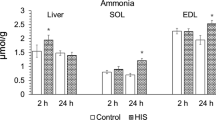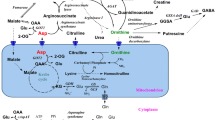Abstract
Carbamyl glutamate injected into normal rats produced no change in blood urea levels. Rats fed a high-protein dict or starved for 48 h had increased blood urea. Carbamyl glutamate injection induced a further increase in the levels of urea in their blood. Also, carbamyl glutamate administered in the drinking water of normal mice produced an increase in blood urea, which was accompanied by a decrease in blood ammonia. The application of these findings to the treatment of urea cycle enzymopathies is discussed.
Similar content being viewed by others
References
Bachmann C, Krahenbuhl S, Colombo JP, Schubiger G, Jaggi KM, Tonz O (1981) N-Acetylglutamate synthetase deficiency: a disorder of ammonia metabolism. N Eng J Med 304:543
Brosnan JT (1976) In: Grisolía S, Báguena R, Mayor F (eds) The urea cycle. John William and Sons, New York, p 443
Brown R, Manning R, Delp M, Grisolía S (1958) Treatment of hepatocerebral intoxication. Lancet I (7020):591
Conn HO, Lieberthal MM (1979) The hepatic coma syndromes and lactulose. William and Wilkins, Baltimore
Grisolía S, Cohen PP (1953) Catalytic role of glutamate derivatives in citrulline biosynthesis. J Biol Chem 204:753–757
Grisolía S, Quijada CL, Fernández M (1964) Glutamate dehydrogenase from yeast and from animal tissues. Biochim Biophys Acta 81:61–70
Hengsgens HESJ, Verhoeven AJ, Meijer AJ (1980) The relationship between intramitochondrial N-Acetylglutamate and activity of carbamyl phosphate synthetase (ammonia). The effect of glucagon. Eur J Biochem 107:197–205
Kim S, Paik WK, Cohen PP (1953) Ammonia intoxication in rats: protection by l-carbamylglutamate plus L-arginine. Proc Natl Acad Sci USA 69:3530–3530
Nuzum CT, Snodgrass PJ (1976) In: Grisolía S, Báguena R, Mayor F (eds) The urea cycle. John William and Sons, New York, p 325
Nyc JF, Mitchell HK (1947) J Am Chem Soc 69: 1382. Cited in: Grisolía S, Burris RH (1954) Preparation of glutamate and carbamylglutamate selectively labeled with deuterium. J Biol Chem 210:109–117
O'Connor JE, Ribelles M, Grisolía S (1982) Potentiation of hyperammonemia by sodium benzoate. A note of caution. Eur J Ped 138:186–187
Shih VE (1978) In: Stanbury MD, Wyngaarden JB, Fredrickson DS (eds) The metabolic basis of inherited disease. McGraw-Hill, New York, p 362
Snodgrass PJ, Lin RC, Muller WA, Aoki TT (1978) Induction of urea cycle enzymes of rat liver by glucagon. J Biol Chem 253:2748–2753
Tremblay GC, Wendler PA (1982) On benzoate therapy for ammonia toxicity. Pediatrics 70:503
Author information
Authors and Affiliations
Rights and permissions
About this article
Cite this article
O'Connor, J.E., Jordá, A. & Grisolía, S. Acute and chronic effects of carbamyl glutamate on blood urea and ammonia. Eur J Pediatr 143, 196–197 (1985). https://doi.org/10.1007/BF00442137
Received:
Accepted:
Issue Date:
DOI: https://doi.org/10.1007/BF00442137




